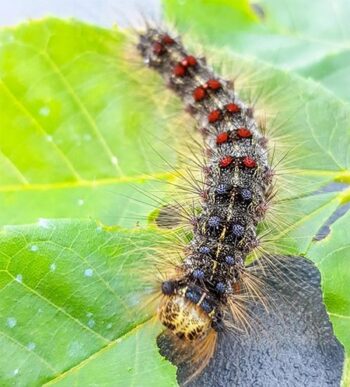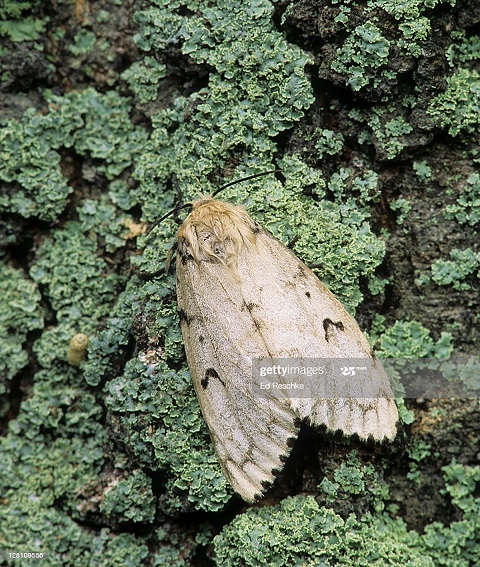NORTHERN MICHIGAN – Gypsy moth caterpillar populations are extremely high throughout the oak forests in northern Michigan. The presence of caterpillars has been a nuisance, and many oak trees have been severely defoliated as the caterpillars continue to eat the leaves.
Population of the invasive insects have exploded across Northern Michigan. And unless there is a millage to help pay for the cost of spraying an insecticide, property owners have limited options.
What can you do?
Installing sticky bands on trees can help keep the gypsy moth caterpillars from climbing back up the trunk of a tree. On hot afternoons, gypsy moth caterpillars spin a web to lower themselves down from the tops of the trees to escape the heat. In the evening, or the next morning, the caterpillar will attempt to climb back up the trunk of the tree to begin feeding again.
Sticky bands prevent the caterpillar’s ascent. Dozens if not hundreds of caterpillars will congregate below the sticky tape where they can easily be targeted with a soap and water spray or plucked off and collected in a bucket of soap and water. Repeat daily.
Sticky bands can be constructed using duct tape and petroleum jelly. Simply wrap three overlapping bands of duct tape, sticky side down on the bark, around the tree. Then, take a small amount of petroleum jelly on your finger and run it across the middle band. Applying petroleum jelly directly to the bark is not recommended and could injure the tree. Similarly, applying too much petroleum jelly will cause it to melt and run down the tape and come in contact with the bark, causing injury.

It may be tempting to use a chemical insecticide on the caterpillars. However, that is not recommended due to the many beneficial insects that could be affected. Rather, use a heavy mixture of soap and water to spray the caterpillars directly.
In addition, while young caterpillars are lethally affected by eating the bacterial insecticide, Bacillus thuringiensis kurstaki, or Btk, applied to the leaves on trees, older caterpillars are not. Spraying the leaves of your trees with Btk at this stage is not effective. Rather, it should be a treatment to be considered just after caterpillar hatch next spring.
Will my tree survive?
Severely defoliated trees should be watered when we have five or more days without rain. Watering will relieve some stress on the trees as they work to grow leaves to replace what the gypsy moth caterpillars consumed. This is especially important while the temperatures remain in the 80- to 90-degree range. To properly water a tree, use a sprinkler to distribute water to the area under the branches of the tree. Most of the fine roots grow further out from the trunk and dispersed watering allows the tree to take up more water than if a hose is left to run at the base of the tree.
Apply one inch of water every five days to each affected tree. Use a baking pan placed in range of the sprinkler to learn how long it takes to deliver one inch of water via your sprinkler. The bulletin on the MSU Gypsy Moth website titled, “Dealing with gypsy moth around your home or property” provides additional detail.
Will this happen next year?
It might, but evidence suggests that two pathogens, or diseases, that affect gypsy moth caterpillars are causing death. The virus and fungal pathogens occur naturally, and levels have been increased to affect gypsy moth populations throughout Michigan. Be on the lookout for dead gypsy moth caterpillars that are either hanging in an upside down ‘v’ formation or are in a straight line to detect if the pathogens have affected the caterpillars on your property.
Evidence of caterpillars having died from these pathogens indicates that the local caterpillar population may be in collapse this year, leading to much lower numbers next year. The article on the MSU Gypsy Moth website titled, “A virus and fungal disease cause gypsy moth outbreaks to collapse” provides additional detail about these pathogens.
Is there a way to predict what will happen next year?
Yes!
Gypsy moth caterpillars will soon be spinning a cocoon where they will morph into flying moths. The moths do not eat, but they do mate and lay eggs. This process should be complete by mid-August in most of Michigan. Counting the eggs and calculating the “egg masses per acre” on your property will allow you to predict the numbers of caterpillars that will hatch next year.
If your property has a high number of egg masses per acre, you can begin planning next year’s plan of attack as early as September 2020.
For more information visit canr.msu.edu/ipm/invasive_species/gypsy-moth


